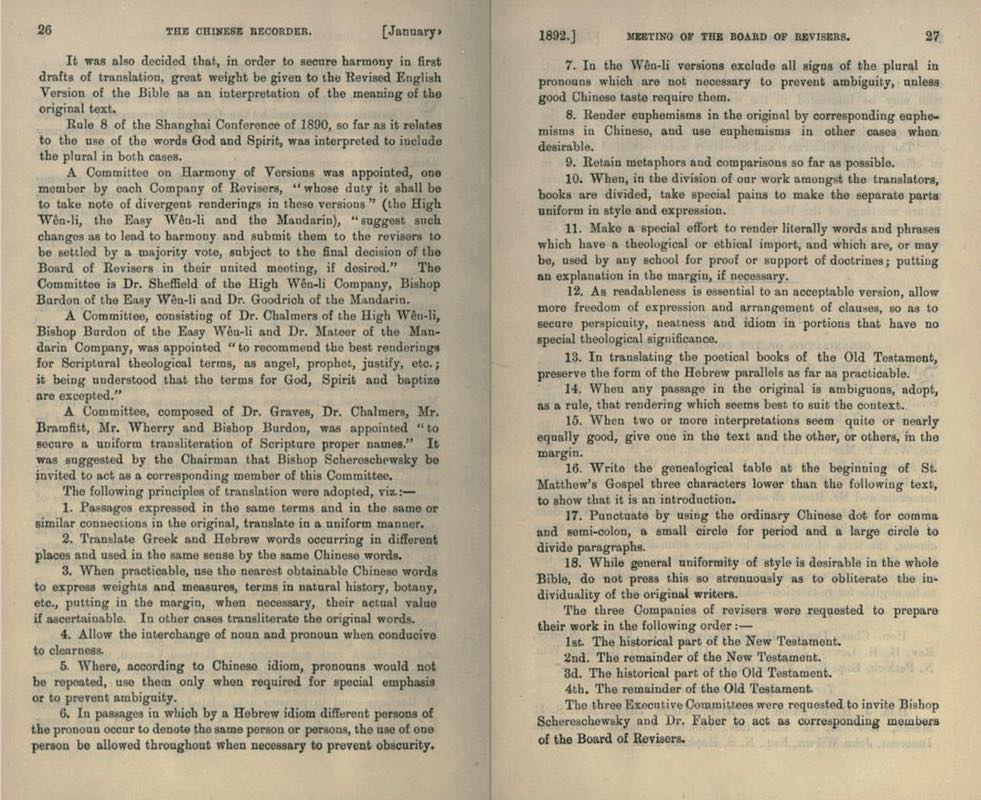[有待更新]
論到翻譯方針,《和合本》與其他譯本的情況不同,其歷史背景、過程、目標等原因,都是很大的課題,寫幾百頁紙也寫不完,若有興趣,可以參考本頁底的幾本著作;這裡倒想說說一些較少人談論的點滴。
研究翻譯方針的起步點

1. Passages expressed in the same terms and in the same or similar connections in the original, translate in a uniform manner.
2. Translate Greek and Hebrew words occurring in different places and used in the same sense by the same Chinese words.
3. When practicable, use the nearest obtainable Chinese words to express weights and measures, terms in natural history, botany, etc., putting in the margin, when necessary, their actual value if ascertainable. In other cases transliterate the original words.
4. Allow the interchange of noun and pronoun when conducive to clearness.
5. Where, according to Chinese idiom, pronouns would not be repeated, use them only when required for special emphasis or to prevent ambiguity.
6. In passages in which by a Hebrew idiom different persons of the pronoun occur to denote the same person or persons, the use of one person be allowed throughout when necessary to prevent obscurity.
7. In the Wên-li versions exclude all signs of the plural in pronouns which are not necessary to prevent ambiguity, unless good Chinese taste require them.
8. Render euphemisms in the original by corresponding euphemisms in Chinese, and use euphemisms in other cases when desirable.
9. Retain metaphors and comparisons so far as possible.
10. When, in the division of our work amongst the translators, books are divided, take special pains to make the separate parts uniform in style and expression.
11. Make a special effort to render literally words and phrases which have a theological or ethical import, and which are, or may be, used by any school for proof or support of doctrines; putting an explanation in the margin, if necessary.
12. As readableness is essential to an acceptable version, allow more freedom of expression and arrangement of clauses, so as to secure perspicuity, neatness and idiom in portions that have no special theological significance.
13. In translating the poetical books of the Old Testament, preserve the form of the Hebrew parallels as far as practicable.
14. When any passage in the original is ambiguous, adopt, as a rule, that rendering which seems best to suit the context.
15. When two or more interpretations seems quite or nearly equally good, give one in the text and the other, or others, in the margin.
16. Write the genealogical table at the beginning of St. Matthew’s Gospel three characters lower than the following text, to show that it is an introduction.
17. Punctuate by using the ordinary Chinese dot for comma and semi-colon, a small circle for period and a large circle to divide paragraphs.
18. While general uniformity of style is desirable in the whole Bible, do not press this so strenuously as to obliterate the individuality of the original writers.
The Chinese Recorder (第23冊,1892年1月),第26-27頁 (點擊放大) 研究《和合本》的翻譯方針,最佳的起步點,是「和合本翻譯委員會」自己在1891年訂立的十八項翻譯原則,原文是英文,記載於 The Chinese Recorder (第23冊,1892年1月),第26-27頁。
表面看,這十八條原則,大部份都是翻譯聖經的老生常談,例如第10條,翻譯團隊中,每人的文筆總有分別,把各譯文初稿組合在一起時,便要「特別努力地」(“take special pains to”) 使各部份的「文筆和措辭一致」(“uniform in style and expression”)。
不過,有些原則卻有商榷餘地;例如第15條,如「有兩個或以上的解釋看似同樣好或差不多」(“two or more interpretations seems quite or nearly equally good”),在經文中採用了一個,便要把其餘放在邊欄中。表面上這是常見習慣,但細心再想,這其實是指哪一種情況?是原文用字刻意含糊?或只是現代學者未能掌握昔日人所共知的意思?又或者作者刻意採用多重意思的詞彙?為什麼第15條原則要用「解釋」(interpretation)這個詞?周聯華(2010,第13頁)嘗試舉〈提摩太後書〉1:12的「我所交付他的」和「他所交託我的」兩個選項作例子;《和合本》選擇了前者,然後把後者作附注:「或譯:……」。就以此例而言,原文的字面意思,只是「我的委託」,字面上似乎沒有指出是「我託他的」還是「他託我的」。在這情況下,譯者應嘗試從上文下理來「解釋」這段經文,還是應該保持原文可作兩種解釋的表達方式?這已經不單單是「神學問題」,更涉及翻譯取向的問題:翻譯聖經,應忠實表達原文,還是表達信仰立場?是誰的立場?譯者個人?某個宗派?整個廣義基督教?甚至跨宗教 (例如《塔納赫》或舊約聖經也是猶太教的聖經,讀者對象應包括不信基督的猶太教教徒)?甚至全人類,包括無神論者和任何宗教?翻譯的目的,是為了忠實傳遞神的話,還是為了傳教?哪一個教?
從歷史角度看《和合本》 研究任何譯本的翻譯方針,都不可忘記其歷史背景。1890年5月,幾個宗派的新教宣教士在上海舉行會議,決議以文言文(深文理)、半文言半白話(淺文理)和官話(即國語)三種文體翻譯聖經。在這些譯者面前,已有的新教文言 (深文理) 譯本包括馬殊曼譯本、馬禮遜譯本、四人小組譯本、委辦譯本、裨治文譯本、高德譯本 (還有東正教的固利乙譯本、英諾肯提乙譯本和天主教的李問漁譯本);半文言半白話的淺文理譯本已有楊格非淺文理譯本、包爾騰、白漢理譯本、施約瑟淺文理譯本;官話譯本有南京官話譯本、北京官話本、楊格非官話譯本,還有天主教的賀清泰譯本。
只計新教,當時已出版的中譯本已經有13種了,為什麼一群以英語為母語的宣教士,還要在1890年打算再出版一個「和合」、通用全國的中文聖經?他們想「和合」誰?試想想當年的歷史背景,便可深入體會了。當年1890年是滿清割讓香港島給英國之後48年、割讓九龍半島給英國之後30年、與英國簽訂《緬甸條約》後4年。結果《和合本》前後花了29年才翻譯完成,這29年又發生了什麼事呢?英國租借新界、義和團、八國聯軍、孫中山成立同盟會、辛亥革命、清朝滅亡、五四運動……清末民初的大事,都在這29年發生。若不仔細研究當時的歷史,不可能全面深入認識《和合本》背後的翻譯理念、目標、和取向。
《和合本》的新約底稿 《和合本》的舊約原文底本所用的《馬所拉文本》(Masoretic Text) ,與今天的最新版本Biblia Hebraica Stuttgartensia,沒有很大的分別。不過,《和合本》的新約原文底本是什麼,便是一個很有趣的問題了。
由十七至十九世紀中,聖經譯者都用1633年出版的《公認經文》(Textus Receptus) 作新約希臘文原文底本,包括當年最通行、在1611年出版的King James Bible (KJV,譯名《英王欽定本》)。
King James Bible中所用的十七世紀古舊英文詞彙和語法,到了十九世紀已不中用,而且KJV當時用的原文底本《公認經文》,部份內容與之後出土的希臘文抄本不符。十九世紀中,英國學者針對King James Bible的不足,重新以現代英語詞彙和語法翻譯聖經,同時由學者魏斯科(Brooke Foss Westcott, 1825–1901) 和霍特(Fenton John Anthony Hort, 1828–1892) 牽頭鑑證希臘文原文,出版全新的希臘文新約版本,書名是The New Testament in the Original Greek,一般稱為Westcott and Hort (1881) (魏斯科和霍特文本),在1881年出版。重新翻譯的英文新舊約全,則在1885年出版,一般稱為 Revised Version (RV) ,又稱 English Revised Version。
1890年,上海在華傳教士大會議決翻譯《和合本》中文聖經,當時要面對的難題是,應該以哪一個版本作新約原文的底本?是沿用了幾個世紀的希臘文《公認經文》,還是新鮮出爐的Westcott and Hort (1881)?以今天學者的眼光看,《公認經文》內容與之後出土的抄本不符,錯漏不少,不是可靠的版本,沒有理由不參考新版本,就像所有教科書一樣,新版通常都比舊版更切合新時代的需要,新不如舊的情況不是不可能,只是較少見。但當時Westcott and Hort (1881) 不僅是「新版」,其實是革新的研究成果。就像其他的學術或科技研究一樣,每當革新的研究成果公布,都總可能會有上一代的學者質疑;聖經研究也不會例外。在當時的環境下,如要完全否定《公認經文》,會是個很大膽的決定。加上伴隨出版的Revised Version (RV) ,也同樣飽受當時的舊一輩學者批評,說其英文翻譯不流暢、欠文學美感云云。
翻譯《和合本》是個大工程,當時先要決定的是,應該用哪個版本作希臘文底稿;另外,如要參考一下英文譯本,應該用哪個版本。當時的在華傳教士大會,作出了很前衛的決議,翻譯用的原文底本是Westcott and Hort (1881),英文可參考 Revised Version。不過,據尤思德博士的研究,《和合本》的譯者在參考Westcott and Hort (1881)之餘,事實上有採用《公認經文》,並沒有百份百依照決議。(尤思德,2002,第277-279頁)
當時在華傳教士大會的決定,與大英聖書公會的立場相反。《和合本》翻譯計劃的資金,主要來自大英聖書公會,資金來源主要是英國信徒奉獻。 無庸置疑,KJV在十七、十八世紀很成功,但這卻令到立場保守的人士以為,上主祝福KJV,也同樣地祝福KJV的原文底本《公認經文》,如完全放棄KJV,便可能會觸動奉獻者的情緒。所以,大英聖書公會編輯監督 (Editorial Superintendent) 威廉.賴特 (William Wright) 明言,大英聖書公會的立場是,《和合本》應以《公認經文》為翻譯基礎,若與Westcott and Hort (1881)有任何差異,才按後者作取捨。
討論《和合本》翻譯方針的著作 過去幾十年,討論《和合本》翻譯方針的著作很多,現推薦其中幾本給大家參考:
ZETZSCHE, Jost Oliver (1999) The Bible in China: The History of the Union Version or the Culmination of Protestant Missionary Bible Translation in China, Samkt Augustin: Monumenta Serica Institute [ISBN: 3805004338]
尤思德 (ZETZSCHE, Jost Oliver) (2002)《和合本與中文聖經翻譯》香港:國際聖經協會(現稱:漢語聖經協會) [ISBN: 9789625132440][中譯本]
麥金華(2010)《大英聖書公會與官話〈和合本〉聖經翻譯》,香港中文大學基督教中國宗教文化研究社 [ISBN: 9789627706212]
周聯華(2010)〈《和合本》譯經原則和評估〉,刊於:謝品然、曾慶豹(2010)《自上帝說漢語以來——《和合本》聖經90年》香港:研道社有限公司 [ISBN: 978-9881867957],第3-16頁